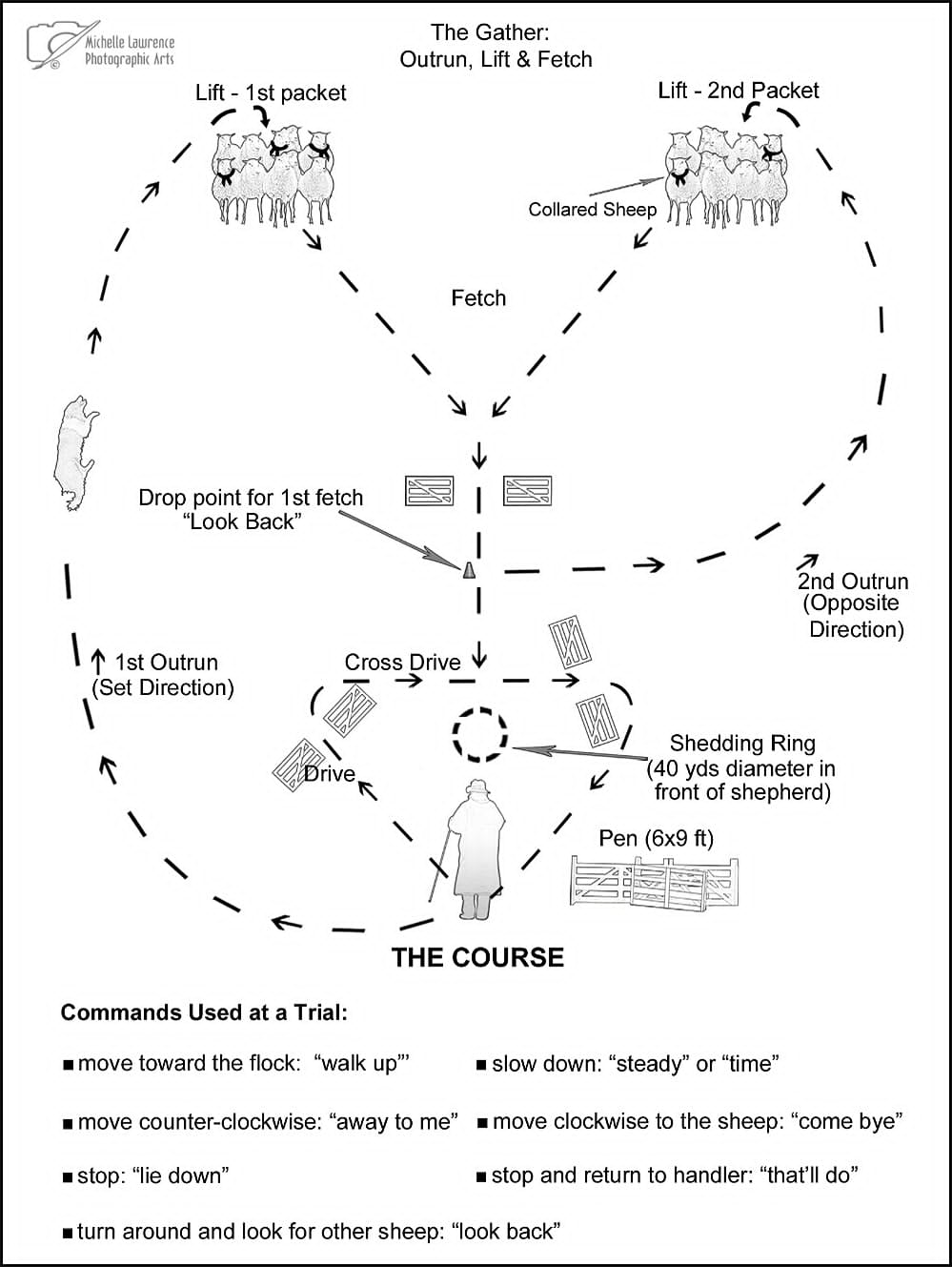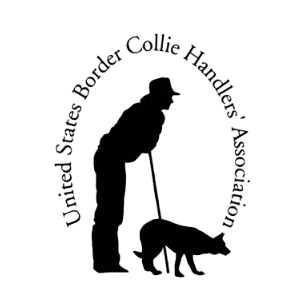trial Diagrams and course descriptions
National-Style Course
A USBCHA “Open” sheepdog trial (so called because it is open to all dogs, regardless of breed or registration status) consists of at least six distinct scored phases of work: the outrun, lift, fetch, drive, crossdrive, pen, and shed/single. The dog and handler must move the sheep in a quiet and straight line through a pre-determined course, losing points if the course of the sheep veers from the ideal or if the sheep are not handled properly by the dog.
For more detailed information about how the runs are scored by the judge, see the USBCHA’s judging sheepdog trials page,

The course begins with the Outrun (20 points). The handler sends the dog (according to his or her choice) either clockwise or counterclockwise. The dog must cast out in a deep, pearshaped arc (without additional commands) that ends when the dog is directly behind the sheep.
The Lift (10 points) is the critical point at which the dog and sheep meet and assess one another. The sheep should start down the field in a straight, orderly fashion. It is at the lift that the dog and sheep begin a relationship that will be maintained throughout the remainder of the run.
The Fetch (20 points) begins immediately after the lift. It should be absolutely straight and should, like all phases of work in the trial, be efficient and workmanlike. The sheep should come right through the center of the fetch gates in the middle of the field and pass behind the handler at the post.
The Drive (30 points) starts at the back of the handler’s post. The sheep must go in a straight line to the first drive gates, make a sharp turn toward the second drive gates, and return in a straight line to the pen. The straighter the lines and the tighter the turns, the better the drive score will be.
The drive ends when the sheep are at the mouth of the Pen (10 points). Ideally, the sheep should enter the pen without hesitation at the pen mouth.
After the pen, the dog and handler will take the sheep into a marked shedding ring for the Shed/Single (10 points). The handler must line the sheep up in a row and call the dog through to turn on the required stock to separate it from the others. In the ideal shed, the sheep in front of the dog will feel able to escape, and the last sheep will feel unable to join them because of the authority of the dog. Proper sheds are taken on the head, with the dog face to face with the chosen sheep before turning her. The judge could ask for a shed (2 or more sheep) or a single (1 sheep) to be split off.
International-Style Course
An international-style course is distinguished from a national-style course by a significant increase in the degree of difficulty: dogs must pick up two packets of sheep rather than one, and separate out the sheep wearing collars from the others before putting them into the pen. An International course is often the culmination of a large trial, in which the dogs who have been most successful on the previous national course compete for championship honors. Whereas a standard national-style course usually has a time limit of 10-15 minutes, dog/handler teams are usually allotted 30 minutes to complete the demanding international course.

The dog will be sent to gather one lot of ten sheep and fetch them through a set of fetch gates. When the sheep have reached a point about twenty yards from these gates, the handler will command the dog to “look back” and then ask the dog to leave the sheep he has just fetched and set out on a second outrun for a second packet of ten sheep that in all likelihood cannot be seen by the dog. Unlike in a national-style course, the direction of the outruns in the double-lift are no longer the handler’s choice: all dogs will be sent the same predetermined way for the first set of sheep, and then the opposite way for the second. Leaving the first set of sheep to seek a second, unseen set requires the ultimate act of trust and obedience on the part of the dog. Once the dog has fetched the second set of sheep through the fetch gates, the two groups of sheep will be rejoined, and the twenty sheep will continue down the field to the handler. The gather is worth a total of 100 points (200 aggregate): 20 for each outrun; 10 for each lift; and 20 for each fetch.
Although long and challenging, the drive is similar to the drive in a national-style course: the dog will drive the sheep in a triangle through two gate obstacles and then back into the shedding ring. The drive is worth a total of 40 points (80 aggregate).
The so-called “international shed” of the double-lift finals is an intricate and advanced exercise. The goal of the dog and the handler is to separate five collared sheep from the rest of the group, allowing the uncollared sheep to drift out of the ring. All of the sheep need to be regathered and shed again if one of the collared sheep leaves the ring with the uncollared ones. The shed is worth a total of 20 points (40 aggregate).
The pen cannot begin until the five collared sheep are properly shed off from the fifteen uncollared ones. On completion of the shed, the handler must proceed to the pen and ask the dog to fetch the five collared sheep. The pen is not complete until all five sheep are inside with the gate closed. The pen is worth a total of 10 points (20 aggregate).
